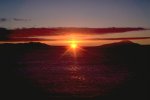
The
Twilight Zone
Darkness, Light and What Lies Between
|
See: Reading
and Writing Connections >>
|
 |
Variations in the Twilight Zone
Historically, three subdivisions of twilight have been used to define outdoor visibility:
- Civil twilight refers to the interval of incomplete darkness that occurs when the sun's center is approximately 6 degrees below the horizon. The amount of light is still sufficient to carry on outdoor work without the aid of artificial light.
- Nautical twilight refers to the interval of incomplete darkness that occurs when the sun's center is approximately 12 degrees below the horizon. The amount of light is still sufficient to navigate using visible features on the surface of water or land. This subdivision ends when it becomes too hard for a sailor to pick out the line between sea and sky.
- Astronomical twilight refers to the interval of incomplete darkness that occurs when the sun's center is approximately 18 degrees below the horizon. There is no discernible horizon glow left over the sun's azimuth. Stars (sixth magnitude) directly overhead.
 |
One of our
newest Journey North classrooms, Hopson Middle School, is located in Barrow,
Alaska. This special place is the northernmost
community in North
America, and is located on the Chukchi Sea coast. Barrow's latitude
is 71 N. In Barrow, the disc of the sun doesn't climb above the
horizon for roughly
a month on each side of the winter solstice. However, at noon on
the winter solstice the sun's upper rim is only about 4´ degrees
below the horizon.
Imagine winter's twilight skies in Barrow!
Try This!
Find out when the sun sets in your area then go outside and watch it set. Does it get dark immediately? Why not? How many minutes pass from the time the sun sets until you can't read the print in a book without extra light? Do you think this time interval changes depending on the time of the year?
Refracted light is a fun concept to experiment with. Try your hand at some experiments to help you understand how light appears to bend:

